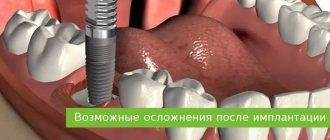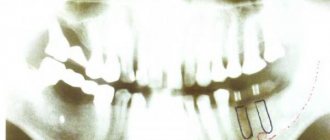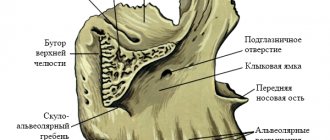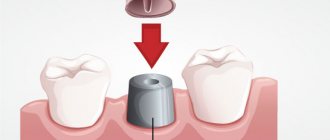Dental implantation is a modern method of restoring lost teeth, restoring chewing comfort, normal diction and an attractive smile. Its essence lies in the implantation of an artificial metal root into the jawbone, on which a crown is installed, indistinguishable in shape, appearance and function from natural teeth. But, as in all other cases, the advantages of this method have their downside.
Some people who study the issue before making a decision about which type of prosthetics to give preference suspect that something is being hidden from them, so everywhere they write only about the advantages of implantation, and about the disadvantages - briefly and indistinctly. We will try to honestly and objectively understand the pros and cons of dental implantation with you.
Honestly about the disadvantages of implantation
Despite the significant advantages - restoration of the chewing load on the bone and stopping the atrophy of bone tissue, the feeling of the implant as if it were your own teeth, excellent appearance, durability and reliability, no need to grind down adjacent teeth - implantation also has its own disadvantages, which we will consider in detail.
1. Pain after implantation. Installation of an implant (or implant - everyone pronounces a foreign word differently) is a surgical operation with all the ensuing consequences - including pain for some time after the operation. During the normal course of the process, the pain goes away within a few (3-5) days.
2. Possible complications. One of the most serious complications is material rejection - the body does not perceive a foreign object and tries to get rid of it. Inflammation, pain, swelling, implant mobility, fluid secretion and even increased body temperature. To be fair, let’s say that the probability of such an outcome is very low - it is only 2-3% of the total number of people who have implants installed.
3. Presence of contraindications. Implantation, like most all medical procedures, has contraindications – situations in which it is impossible to install implants. These include: age under 20 years, diabetes mellitus (type 2), hepatitis, AIDS, other immune and cardiovascular diseases, bleeding disorders, bruxism and some others. Some of the contraindications can be circumvented, others cannot.
4. Long installation process. The installation itself can be carried out in literally 1-2 visits to the dentist, but the total period of engraftment of the artificial root can take from 6 months to 1-2 years. But in case of a favorable outcome (and this, we remind you, is 97-98% of all cases), you will have the same tooth as before, which will serve you without any problems for 10-20 years, or even more.
5. Caring for implants is more complicated than regular teeth, although not by much. They need to be cleaned more thoroughly, and you also need to regularly visit a dentist, who should monitor the condition of the implant and take timely measures if any problems suddenly arise.
6. The cost of implantation is very high. Prices for installing one implant start from 18,000 rubles - and this does not include the cost of the crown. In other clinics (especially in the capital), the total cost of a new tooth can exceed 100,000 rubles or more.
Still, the pros outweigh the cons in most cases. Otherwise, implantation would not be used so widely, and this technology, for a moment, is already more than 55 years old. The first operation was successfully performed by the developer of this technology and the founder of Nobel Biocare (which is still a leader in the scientific development and production of implants) Per-Ingvar Brånemark back in 1965.
Since then, millions of operations have been performed all over the world, several more large companies have appeared producing implants, instruments and components, implants of a more advanced form and from the latest, biocompatible materials have been proposed, the technology has been developed to perfection, and research into the consequences of implantation has become the most extensive nature, including many thousands of patients observed over decades. But still, let’s return to the disadvantages of implantation and analyze them more carefully.
Indications
Indications for dental implantation:
- complete absence of dentition;
- missing one or more teeth;
- patient's reluctance or inability to use removable dentures;
- increased wearability of enamel;
- lack of closure of teeth.
The decision on the need to install pins is made by the dentist based on the results of a comprehensive examination.
Pain after dental implantation
The first disadvantage that scares many is the pain after installing the implant. It appears immediately after the anesthesia wears off and lasts for several days. It is caused by the fact that the surgical implantation procedure involves some damage to soft tissue and bone, which must subsequently regenerate, as well as the placement of a metal pin - an artificial root - into the jaw, which must take root.
In the vast majority of cases, the damage heals within three to five days, and the pain after dental implantation, which is dull, aching, and not very pronounced, gradually stops. These unpleasant sensations are comparable to pain after tooth extraction and disappear completely within a week after surgery.
If the pain is severe, has a cutting, pressing or jerking nature, is poorly eliminated by analgesics and does not go away within 3-5 (maximum 7) days after surgery - this may be a sign of the onset of a pathological process and almost always (with very rare exceptions) indicates about mistakes made during implantation.
Service life and how to care for implants
The service life of high-quality implants ranges from 10 to 25 years or for life. A low-quality implant may be rejected after 1-5 years, and it is not always possible to replace it.
It is not always possible to understand that a structure requires replacement. In some cases, the patient begins to be bothered by obvious symptoms - the gums rise or swell, and hurt. In others, the pathology is noticed by the doctor during an examination. Dentists recommend visiting a doctor annually for preventive purposes, even after restoration of the entire oral cavity.
Possible reasons for the end of the implant’s service life:
- injury;
- design rejection;
- peri-implantitis.
The service life of crowns depends on the material from which it is made. A plastic crown will last only 2-3 years, and a metal-ceramic crown will last 10-15 years.
To minimize the likelihood of complications, follow these recommendations:
- Be responsible when choosing a clinic and doctor. Sometimes it is better to overpay a little, but be confident in the high professionalism of the doctor. A common cause of construction failure is incorrect actions by the implantologist.
- Stop smoking. Cigarette smoke provokes mucosal irritation and inflammation, and damages crowns.
- Do not place excessive stress on the implant. Do not crack nuts with dentures or open bottles.
- Perform oral hygiene daily morning and evening, use dental floss throughout the day, and give preference to an electric toothbrush.
- Get an annual dental checkup and professional cleaning.
- Avoid facial injuries.
Following these rules will help you maintain a beautiful smile for many years.
Causes of pain after implantation
The most common reason for the development of pathology is the penetration of infection into the wound during or after surgery - for example, when using insufficiently sterile instruments or materials, the penetration of pathogenic bacteria through the edges of a loosely sutured wound, or when the sutures come apart. In some cases, with insufficiently qualified implantation, damage to the nerve structures of neighboring tissues occurs, which causes intense aching pain, which is practically uncontrollable by analgesics.
Another possible cause is the formation of a blood clot between the implant and the gum tissue, resulting from a damaged blood vessel or a bleeding disorder in the patient. Normally, after surgery, the patient experiences a subtle aching pain that goes away within 3 days, as well as slight bleeding, swelling and swelling at the operation site.
All this is a consequence of surgery and the reaction of the body’s immune system to it and goes away in 3-5 days. If the pain is severe, acute, there is severe swelling of the gums, fluid is released from under the installed structure, and all this continues for more than 5 days - this is a signal that you need to seek help from a doctor.
What other conditions affect the possibility of installing implants?
Features of implantation in women
The female body is characterized by a number of conditions that cannot be called pathological, but they become temporary obstacles to the implementation of implants:
- Menstruation. Doctors recommend refraining from surgery during menstrual bleeding. The main danger is excessive blood loss and the possibility of uncontrolled bleeding. The operation is complicated by the high risk of blocking blood vessels, since during menstruation the blood in the female body has increased clotting. During menstruation, patients are susceptible to nervous breakdowns: the procedure can harm the woman’s morale.
- Pregnancy. Anesthetics and other medications, X-rays have a negative effect on the unborn child. Also, during pregnancy, the immune system is weakened and cannot fully resist pathogens, which creates a risk of developing inflammation.
- Breast-feeding. During breastfeeding, medications administered to the patient pass into the milk. Toxic substances cause allergies and other undesirable consequences in the baby.
A woman needs to wait until these conditions pass. Then it will be possible to install implants.
Are there any restrictions for older people?
Older patients must be sent for examination of the state of their health. If older people do not have general obstacles to the procedure, implantation is not contraindicated, but the recovery period takes longer. This is due to a slowdown in regeneration processes in old age. To reduce the risk of complications, dentists carefully prepare the patient’s oral cavity and choose minimally invasive surgical methods.
Is implantation performed for children?
in children under 18 years of age . As a child grows, jaw bones grow and teeth change. If an implant is placed in childhood, over time it will become too small and will have to be reinstalled. If the baby does not have dental units, dentures are used. The issue of implantation is decided upon when the child reaches the age of 18-22 years.
Is it possible to install implants for smokers?
Smoking increases the risk of implant failure. One cigarette smoked after surgery reduces tissue repair by 30% . But this is not the only danger. When smoking, the mucous membrane burns and the wounds heal slowly. A bad habit leads to disruption of saliva production. The mouth constantly feels dry, the mucous membrane is not cleared of pathogenic bacteria, and the risk of infection increases.
How to reduce pain after implantation?
It is necessary to understand that after surgery the body needs time and energy to recover, so it is important to carefully listen to the doctor’s recommendations and strictly follow them - refuse solid food during recovery, chew on the other side of the jaw, do not drink alcohol or smoke, do not go to the sauna and a sauna in the first month after implantation.
You must brush your teeth carefully, using a soft-bristled brush, try not to injure the tissues of the oral cavity, avoid physical impacts (impacts, shocks), observe good hygiene, promptly use medications (including antibacterials) prescribed by your doctor, and do not take other medications. without consulting a doctor.
To reduce pain, you can use cold lotions (with ice) in the first hours after implantation. They are used no longer than 20-30 minutes to avoid tissue hypothermia.
Regularly (especially after eating) rinse your mouth with water and antiseptic solutions (for example, chlorhexidine-based).
Healing gels (such as Metrogyl Denta) or cotton swabs moistened with an antiseptic solution (chlorhexidine) can be applied to the area of the gums where the sutures are located.
You can use analgesics (ketanov, paracetamol, ibuprofen, nimesil), observing dosages and intervals between doses. Their effectiveness is enhanced by drinking plenty of fluids.
Among folk remedies, it is allowed to use a decoction of chamomile, eucalyptus, calendula, plantain, as well as a pulp of fresh aloe leaf. You can rinse your mouth with decoctions (or tincture diluted in water) or moisten cotton swabs and apply to the sore spot.
Attention! Any means are used only as prescribed by a doctor or in agreement with him! Carefully follow the requirements and recommendations of the implantologist and do not self-medicate. And if the pain is too severe, consult a doctor.
According to the form they are distinguished:
Cylindrical
Thanks to the porous structure, a strong connection with the surrounding bone tissue is ensured. Currently, cylindrical implants are produced dismountable, designed for a two-stage application method.
Screw
In order to have an idea about these implants, let's look at the structure of the jaw bone.
The cortical plate is a kind of shell, the strongest, consisting of 95% mineral salts.
Spongy bone is the main layer of bone tissue, represented by crossbars and septa with many small vessels (capillaries). It is in this section that the roots of the teeth are located.
The basal layer is a continuation of the spongy layer, but the septa are located closer with a small number of vessels. Maximum strength and thickness .
Screw implants have a number of advantages:
- Cone shape;
- They are installed in place of the roots of natural teeth, that is, in the spongy layer. When chewing, they also transfer the load to the surrounding bone tissue, thereby maintaining metabolic processes in it at the proper level. It turns out that this type of implant is the most physiological;
- The presence of threads, which increases the area of contact with bone tissue, and, consequently, faster osseointegration is noted;
- They can be collapsible or non-removable, one- and two-stage, have a smooth, rough surface or a coating of bioactive materials;
- They come in different diameters and lengths, which expands the indications for their use.
One of the main conditions for the use of screw implants is the presence of a sufficient volume of high-quality bone. But even if there is a lack of it, it is possible to establish them with the help of additional operations (sinus lifting, bone grafting, etc.). Only the duration of treatment and recovery will change.
In today's market you can see many implant manufacturers. Let's take a look at the leading representatives.
Complications during dental implantation
Implantation is a well-developed procedure over decades, studied in every detail, studied not only in the short-term consequences, but also in the long term. Therefore, with proper treatment planning and compliance with the entire dental implantation protocol, complications occur extremely rarely.
In most cases of complications or material rejection, the cause is violations of the surgical technology or a doctor’s error associated with a lack of experience, leading to the wrong choice of tools and equipment, violation of the rules of compliance with aseptic and antiseptic requirements, errors in preparatory procedures, implantation with insufficient bone tissue, injuries during surgery.
On the other hand, an error or negligence may be made by the patient, and complications may arise for this reason. For example, violation of restrictions on food intake (excessively hard or traumatic), alcohol consumption, physical exposure, failure to comply with hygiene or the requirements of antibacterial therapy, taking medications that reduce the effectiveness of treatment, etc.
Some complications may occur immediately after surgery, while others may occur after some time. Postoperative complications may include severe bleeding, sinusitis, or damage to the facial nerves.
If the patient has hypertension or cardiac pathology associated with rhythm disturbances (tachycardia), heavy bleeding may develop. Damage to the maxillary sinus due to unsuccessful implantation in the upper jaw can cause an inflammatory disease - sinusitis.
Due to direct damage, or pressure from the hematoma on nearby nerves, a disturbance in the transmission of nerve impulses may develop, a sign of which may be pain or persistent numbness of part of the jaw. More long-term consequences of implantation are peri-implantitis and rejection of the installed structure.
Peri-implantitis is an inflammation of the tissue around the implant, usually caused by an infection that entered the wound either with unsterile instruments, the material itself, particles of saliva during the operation, or later, through poorly placed or broken sutures. Other reasons may be the patient's failure to maintain proper hygiene or food intake after implantation, a violation of the treatment regimen, or injury.
With the development of inflammatory processes around the artificial root, new bone tissue and soft tissue around the implant cannot form (or are destroyed). The process is accompanied by pain, swelling, unpleasant putrid odor from the mouth, discharge of pus, as well as mobility of the installed implant, and even an increase in body temperature. This condition leads to the loss of an artificial structure - a tooth or denture.
This can happen a year after implantation. And if such signs appear, you should immediately consult a doctor. Treatment in these cases is always individual - it completely depends on the cause of the complications and the clinical picture. In some cases, it is necessary to remove the implant and install a new one in its place, in others, it is necessary to use other methods of prosthetics.
As already mentioned, the risk of such complications is extremely small - at the level of 2-3%. It can be minimized by choosing a qualified, experienced doctor who does not make mistakes, as well as by strict adherence to all his recommendations by the patient.
Types and features of dental implants
There are 6 types of implants:
- intraosseous root-shaped;
- intraosseous in the form of a plate;
- combined - plates with pins;
- subperiosteal, located under the periosteum;
- endodontic, inserted through the root apex.
- Submucosa is injected into the gum and is used to stabilize removable dentures.
The doctor chooses the implant after assessing the condition of the patient’s jaws. Intraosseous implants are the best option; they are used in most cases. The products are strong, durable, and imitate the root well.
Subperiosteal implants are installed when the bone is thinned and damaged. This product is made in the form of a frame, similar to a saddle, which is placed under the gums.
The endodontic type is used if part of the root is preserved. The product helps to lengthen the root and secure a fixed prosthesis. This method is the most gentle, as the implant takes root quickly.
Contraindications to dental implantation
Unfortunately, it is not always possible to install implants. Contraindications to dental implantation include relative and absolute.
Absolute conditions include the presence of serious chronic diseases:
- diabetes mellitus,
- severe liver and kidney diseases,
- oncology,
- tuberculosis (in open form),
- immune diseases,
- cardiovascular,
- nervous diseases.
In addition, contraindications include childhood, allergic reactions to anesthetics, diseases that impair blood clotting, and bruxism (teeth grinding).
Relative (or temporary) contraindications include:
- pregnancy and breastfeeding,
- caries, inflammatory diseases of the oral cavity,
- malocclusion,
- smoking, alcoholism and drug addiction,
- infectious diseases,
- taking immunosuppressants.
At the same time, it should be noted that many diseases in remission allow implantation to be carried out by choosing the right technology and medications.
Preparation is the foundation of subsequent treatment
Before dental implantation, the doctor will definitely examine the condition of the oral cavity for the presence of any diseases and will definitely eliminate them. In addition, the patient needs to undergo an X-ray examination - cone beam or multispiral computed tomography of the jaw and undergo a series of tests.
Based on the diagnostic data, the dentist will plan the implantation. In special computer programs, the models and number of implants are selected for a specific patient, and they are placed on a virtual “jaw”. Additionally, surgical templates are printed to ensure precise placement of the implants so that they are placed in the specified areas and can withstand chewing loads for many years.
Pros of dental implantation
As we have already said, implantation has not only disadvantages, but also very significant advantages. In many cases, they outweigh the disadvantages of dental implants; in addition, there are situations when implantation is the only way out - for example, when a denture causes a gag reflex, or in the case of the loss of all teeth, when there is no other support for the orthopedic structure.
Aesthetics
This is the first most important advantage: artificial teeth on implants cannot be distinguished from natural ones by their appearance, while dentures are often noticeable to a careful eye.
Naturalness of sensations
After implantation, artificial teeth are no different from your own - you don’t even need to get used to them, because... they completely reproduce the shape and function of natural teeth. It will take much longer to get used to dentures, and some people cannot get used to them completely.
Natural gum contour
The gum former restores its original shape and subsequently the gum contour completely coincides with the natural one, in contrast to prostheses, which constantly act on the gum, changing its shape.
Stopping bone atrophy
When a tooth is lost, the chewing load that it exerted on the jaw bone disappears, and this entails atrophy (resorption) of the bone tissue, which sooner or later will affect the neighboring teeth, leading to their displacement and loosening. The implant transfers normal load to the bone, just like a regular tooth, so atrophy does not occur and the neighboring teeth are not in danger.
Hassle-free power supply
Dietary restrictions are set only for the period immediately after implantation - until the artificial root takes root completely. After this, the implants are no different in their functions from natural ones, so they can chew any food, even hard ones. The implants will not suffer from this and will not fall out like dentures.
Preservation of adjacent teeth
A typical case of prosthetics is the grinding of adjacent teeth on which the prosthesis rests. This leads to their gradual wear and subsequent loss. The implant does not require treatment of adjacent teeth and allows you to save them completely.
Durability
All leading manufacturers provide a lifetime warranty on their implants. This means they will last for many years. Only the crown will need to be replaced approximately once every 10 years as it wears out. The implant itself will last for the rest of your life. And if something happens to it, the manufacturer provides a free replacement.
Full functionality
It is not always possible to fit dentures well so that they do not spoil diction or interfere with chewing food. There is no such problem with implants. They fully reproduce aesthetics, diction, and chewing function without any restrictions. And in case of complete loss of teeth, a denture on implants is the only alternative to constantly falling out false jaws.
Prevention
By preventing bone tissue atrophy and preventing the displacement and loosening of neighboring teeth, implants prevent the development of damage to their roots - periodontal disease.
We looked at the pros and cons of dental implants in general and, as we see, in some cases there is simply no alternative to installing implants. At the same time, the most important thing for the patient is not to choose certain models or manufacturers, but to choose a good doctor. Because implants from all leading manufacturers provide the same highest level of quality, but doctors have different abilities and experience.
At the Dental Master clinic you will find an experienced team of doctors with extensive knowledge and qualifications to carry out any type of implantation. An implantologist will select the most suitable material for your case, plan all stages of treatment, carry out the necessary diagnostics and install implants, with which you will not have any problems.
What is a dental implant
A dental implant is a metal structure in the form of a frame or pin that is implanted into the jaw, acting as a tooth root.
Subsequently, a permanent prosthesis is attached to the implant. An implant is necessary to secure a crown or bridges. Installing a pin does not require grinding of adjacent healthy teeth, and dentures fixed in this place will not slip or move. In addition, implants allow you to avoid atrophy of the gums and jaw muscles with age, as they imitate the root.
If we compare implants with other methods - removable dentures and crowns, then implants are much more convenient to use. The patient feels confident; there is no need to constantly remove dentures. Crowns secured to pins sit tighter and look beautiful. If you install crowns with bridges on incisors, the appearance will not be aesthetic.
Orthopedic stage
Goal: complete restoration of the integrity of the dentition.
The doctor takes impressions. After the crown is made in a dental laboratory, it is placed on the implant.
Or, a fixed full prosthesis on 4 or 6 implants is manufactured and installed.
Our dental clinic performs dental implantation at a price of 18,000 rubles.
Still have questions about how dental implants are placed? Sign up for a free consultation with an implant surgeon by phone. +7 495 369 94 71 and receive detailed answers to your questions!
Lamellar
Plate implants
The intraosseous part is a wide thin plate with a textured surface (macrorelief in the form of a snake or corrugated structure) and holes. Such implants are practically not used, as they have more disadvantages than advantages.
Firstly, they differ in shape from the roots of natural teeth, thus they are not able to withstand and distribute the chewing load in the proper volume. Therefore, the service life is not long.
The only positive thing that can be noted is the low cost.
Hi-Tec implants
Hi Tec Implants is one of the leading Israeli companies that has been producing a wide range of implants for over 20 years. During this period, the company has established itself as a representative of quality materials at an affordable price .
Advantages and features:
- A wide selection of types of structures, which allows you to choose the optimal one for each specific clinical situation;
- The implants are made of the highest quality titanium;
- Simple surgical protocol (operation progress);
- Having our own full-cycle production allows us to ensure a high level of quality control of dental implants (implants) and a reasonable cost.
Thus, this implantation system combines high quality and reasonable cost. Among mid-level implants, Hi-Tec takes first place.
Combined
The shape and size of such implants are determined strictly individually, depending on the number of lost teeth, the thickness of the jaw bone and other factors.
Highlight:
- Lamellar-root-shaped;
- Disc: for weak, atrophied bone in cases where bone grafting is impossible;
- Transosseous: used for severe atrophy of the jaw bone, installed through an incision in the chin area;
- Ramus-frame dental implants: a fairly extensive design that covers almost the entire jaw. It is used for severe bone atrophy and serves as a support for both removable and fixed prostheses.
Such implants are used only in cases where screw installation is not possible. The operation requires more time, the process is complex and traumatic . The recovery period is much longer, and the service life is short.
ASTRA TECH implants
ASTRA TECH implants
The system was developed by Swedish scientists and is popular in many countries.
Advantages and features:
- Made of the highest class titanium, which has excellent biochemical qualities;
- Modified OsseoSpeed surface, which accelerates the process of osseointegration;
- The connection of the implant to the Conical Seal Design abutment is located below the gum level, which allows for a more even distribution of the chewing load;
- Patented microthread in the upper part of the implant (in the neck area), which also improves the distribution of chewing pressure;
- The company provides a lifetime guarantee.
Among the disadvantages, high cost can be noted.










